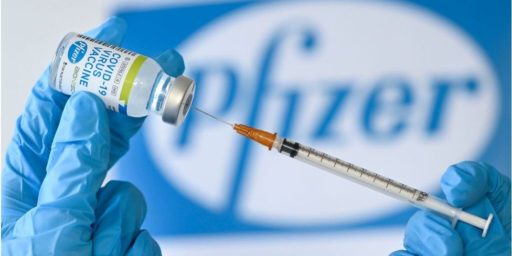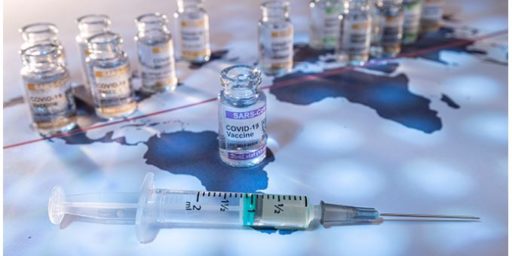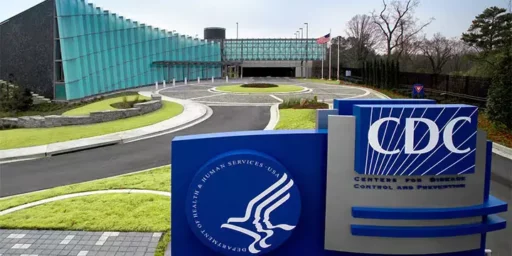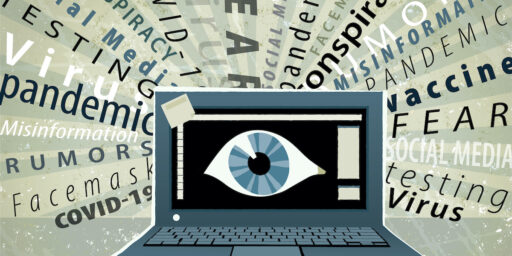COVID Boosters in the Endemic Phase
How long rather than how many?

The Atlantic‘s Katherine J. Wu writes “Annual COVID Shots Mean We Can Stop Counting.”
By this point in the pandemic, a lot of people must be losing track [of how many doses of the vaccine they have gotten]. “I actually think this is a good thing,” says Grace Lee, a pediatrician at Stanford, and the chair of the CDC’s Advisory Committee on Immunization Practices. Now that so many Americans have racked up several shots or infections, she told me, the question is no longer “‘How many doses have you gotten cumulatively?’ It’s ‘Are you up to date for the season?'”
The flip is subtle, but it marks a rethink of the COVID-vaccination paradigm. We’re at a define-the-relationship moment with these shots, when people are trying to commit—to normalize them as a routine part of our lives. At a September ACIP meeting, CDC officials noted that “we are changing the way we are thinking about these vaccines,” and trying to “get on a more regular schedule.” If COVID shots are here for good, then at least we can be rid of the bother of counting them.
Counting doses was more apt early in the vaccine rollout, when it seemed that two jabs (or even one) would be enough to get Americans “fully vaccinated” and out of the danger zone. When more shots followed, they were often advertised with confusing finality: What some initially described as the booster was later retconned as the first booster after a second one was recommended for certain groups. But with immunity against infection more fragile than some hoped, and a virus that quickly shapeshifts out of antibodies’ grasp, those ordinal adjectives have stopped making sense. Until our vaccine tech becomes much more durable or variant-proof, repeat doses will be, for most of us, a fixture of the future—and it won’t do anyone much good to say, “‘I’m on shot 15’ or ‘I’m on shot 16,'” Angela Shen, a vaccine expert at Children’s Hospital of Philadelphia, told me.
The numbers certainly matter when they’re small: It will continue to be important for people to count off their first few shots, for instance, especially those without a history of infections. But after that initial set of viral-spike-protein exposures, the total count is moot. In most cases, about three vaccinations or infections—preferably vaccinations, which are both safer and easier to accurately track—should be “enough to fully charge up the immune system’s battery” for the first time, says Rishi Goel, an immunologist at the University of Pennsylvania. Further COVID shots will help only insofar as they can recharge the battery toward max capacity when it starts to lose its juice. Scheduling a vaccine, then, becomes a matter of “how long it’s been since your last immunity-conferring event,” regardless of how many exposures a body has racked up, says Avnika Amin, a vaccine epidemiologist at Emory University.
That strikes me as right. Certainly, people will lose track if we’re still getting doses years from now.
Anecdotally, it seems to matter some. After avoiding it for nearly two years, I finally tested positive for COVID Saturday morning and again yesterday afternoon. My symptoms have, thankfully, been quite mild—akin to modest seasonal allergies and less than is typical for me when I have a cold. Indeed, my worst bit was a few hours Friday morning before I actually tested positive. Were it not COVID, I’d have gone to the office all week. As it was, I’ve worked from home.
I caught it from my wife, who started experiencing symptoms the previous Sunday night and was hit pretty hard Monday through Wednesday—akin to a serious flu. She tested positive Tuesday afternoon.
I’m one shot ahead of her on the vaccine. We both got our first booster last November and both decided the authorized second booster for over-50s wasn’t worth the after-effects. I did, however, get the bivalent booster in September, and, for whatever reason, she procrastinated.
It’s quite plausible that my more recent dose was the difference in how hard we were hit. It’s also plausible that the fact that my latest dose was formulated against newer strains was a factor.
Regardless, it’s important to note that we’re still trying to figure this all out. Right now, it looks like a booster timed to coincide with the annual flu shot is ideal. Indeed, manufacturers have been looking to combine the two into a single dose. But that’s just an early best guess:
The optimal pace for COVID vaccination will also depend on the speed at which the virus spews out variants. A yearly schedule works for influenza, Shen told me, but “we know flu’s cadence.” SARS-CoV-2 hasn’t yet settled down into a predictable, seasonal pattern; its waves aren’t relegated to the chilliest months. The degree to which we, as the coronavirus’s hosts, tamp down transmission also matters quite a bit. Having more virus around puts more pressure on vaccines to perform, especially when there aren’t many other mitigation measures in place. If all this talk of “once a year, each fall” turns out to be another red-herring recommendation, Amin told me, it could undermine any messaging that follows.
Indeed, messaging is a key:
If we’re going to pivot from numbering doses to timing them, we might as well take the opportunity to discard the term booster as well. Some people don’t understand what it means, Limaye told me, or they default to a logical question—How many more boosters will I need? Plus, booster may no longer fit the science. “When we start updating formulas, it’s not really a booster anymore,” Amin told me. That’s not how we generally talk about flu shots: I certainly couldn’t tell you how many “boosters” of that vaccine I’ve had. (I don’t know, maybe 14? 15?) Pivoting to a terminology of “seasonal shots” could make COVID vaccination that much more routine.
Of course, it would help if this hadn’t all been so politicized.






We are 100+ years from the 1918 pandemic and still getting annual flu shots, so I’d say “settle in”.
Of course, annual uptake on flu shots is fairly low. On average, it’s 50% for adults, and 60% or so for children. So saying it’s going to be like a flu shot doesn’t fill me with confidence.
Honestly, you’re doing yourself, your colleagues, and everyone else a favor if you stay home with a cold or flu. Which I can easily do because my employer not only doesn’t dock my pay but encourages staying out of office while sick. Would be nice if this was not an uncommon policy in other businesses.
Actual conversation yesterday:
Me: Did you get this season’s flu shot?
Grip: No. Hell no. My Sister In Law’s best friend got it and she’s paralyzed now from the waist down. The flu shot paralyzed her.
Me: Huh… (walks away, mumbling under my breath) .. Idiot.
@Argon: By Monday, my symptoms were virtually non-existent–mildly stuffy nose and itchy eyes. For the first year or so after COVID, we’d gotten pretty smart at work with “even if it’s not COVID, stay home if you’re sick.” But, since so many of our faculty and students have young kids, it meant a significant number of people were out on any given day. At some point, I think leadership became suspicious that people were milking it and thus started giving side-eye to those who stayed home.
@EddieInCA:
One of my favorites songs from Joan Manuel Serrat is called “Uno de mi calle me ha dicho que tiene un amigo que dice conocer a un tipo que un día fue feliz.” This translates as “Someone in the neighborhood has told me he has a friend who says he knows some guy who was once happy.”
If we could tax third-hand horror stories, we’d eliminate all deficits and sovereign debts all over the world.
The reality is that the latest variants are so contagious that lockdown, masking, etc are just not going to stop it in the general public (although an individual willing to mask all the time and stay out of public spaces could avoid it for quite a long time, perhaps indefinitely.) But bottom line, a virus that is this transmissible before symptoms show, and has this many variants, is going to be endemic.
Even China may be giving up, although in a typical Chinese fashion – they are talking about maintaining the lock down policy forever, but shifting the responsibility of testing onto the public themselves. It’s unclear how this would play out in practice but one way is that gradually people stop testing or, more likely, go to specific places to get “negative test results”. If there is a severe outbreak the government will be shocked, shocked I tell you, to find cheaters and crack down on them. A lot of Chinese regulation seemed to work this way when I lived there. It was the only way to square the circle between “eternal and unceasing vigilence” and “we have stuff to do”.
I had covid a couple of months ago. It was before the new boosters were available to me, and it had been six months or more since the last booster. It was basically an unpleasant cold. I would have assumed it was a cold if I had no home tests handy. Initially, I took a test when the symptoms started, and it was negative, but then I tested again a couple of days later when they got worse and it was a strong positive.
Since then, I got the new shot as well as my flu shot.
As the symptoms change to more resemble a cold or flu, and since the government is no longer providing free tests, I expect that Covid will fade to be just another cold-like sickness. I doubt people will spend $10 for every home test, or go to a medical center to get tested every time they have cold-like symptoms.
@Kathy: The title of that song reminds me of stories by Juan Rulfo that I read in a lit class in graduate school. A favorite line of his, that I used in my thesis, was “The church in Luvina has no steeple. It would be presumptuous of Luvina to reach toward heaven.”
@Andy: Yes. And, really, do you want to know? At work, our protocols require masking for 10 days if you have “close contact” with a known positive. The strong incentive, then, is not to test.
@Andy: As it becomes endemic, it will also become more of a “business as usual” phenomenon anyway. How many people get tested to determine that they’re sick from influenza in any given year? Probably only the few for whom making the specific diagnosis will prove important to treatment, and probably not even all of them.
@James Joyner: People will not want to test because they’d be required to mask–preferring to be disease vectors instead? What kind of sick [expletive, deleted] do you work with anyway?
@James Joyner: (and others)
Re the incentives to get tested, I thought this was well done.
@Andy:
Makes sense. After all, I don’t think I’ve ever been tested for the flu in my life and I’m sure I’m fairly typical in that. Still, the epidemiologists have ways of determining the flu rate every year and I presume they will use similar methods for COVID. But I wouldn’t be surprised if it came public under a wider umbrella of of “viral respiratory illnesses” or similar.
@Andy:
Quoted for emphasis.
@Just nutha ignint cracker: The widespread consensus, alas, is that this thing has now become no worse than the common cold, at least if you’re vaccinated. People are willing to stay home when they’ve got a cold, to avoid giving it to others. But if the requirement is that they mask even if they’re asymptomatic when they merely spend a few minutes around someone who gets it—something that is going to be routine—they’re going to balk.
@James Joyner:
Unless you want a vacation, which this brilliant SNL bit highlights.
@Mimai:
I see you beat me to the punch with the SNL piece!
@MarkedMan:
Until COVID came along, there were no easy tests for the flu, or anything else. They could do the tests, but since the treatment was going to be the same no matter what you had, there was no point in testing. Easy-to-use, at home tests for respiratory illnesses are new, and could be really helpful, if we could get people to use them, which we mostly probably can’t. As has been said, it’s better not to know.
I’ve got two young daughters, and while I did test them every time they had a cold, and kept them home when they had COVID, prior to their vaccination, if I hadn’t known they had COVID, I could have sent them to school. And part of me is really angry at whoever sent their child to school with COVID, the other part of me can understand why they did. I’m lucky, in that I can work from home, and have very understanding managers. Many people aren’t.
@James Joyner:
My incentive would be to find a job where I can work remote, rather than hang out with you plague rats.
Failing that, cut back on my allergy meds so I am sneezing a lot, and scare the shit out of everyone.
Anyway, I hope you and your wife do not experience any long-COVID symptoms, like brain fog, extreme fatigue, tinnitus, heart problems, kidney problems, etc.
@James Joyner: And I assume you were masking at work due to the close contact with your wife?
(I had initially put “close contact” in quotes, as I was quoting the policy, but it read as lewd so I removed them)
@Gustopher: Thanks. We’re both essentially recovered from our initial bout, so we’re likely safe.
In our case, we’re a resident school that in essence competes with a much larger nonresident program offering a lighter version of our curriculum. That created a lot of pressure for us to get back to in-person teaching way before it made any sense (August 2020) and to bend over backwards to have people in the classroom. It’s a bit weird, to be honest, but perfectly understandable from a bureaucratic politics perspective.
@Gustopher:
Yes but. She seemed to have a mild cold on Monday and Tuesday so we didn’t think much of it and I went into work as usual. As I was driving home Tuesday, she called to tell me she had COVID. I worked remotely Wednesday, got crap for it, so went in with a mask Thursday. I felt symptomatic Friday, even though I tested negative, and stayed home. Saturday, I tested positive and I’ll stay out the rest of the week.
@James Joyner:
I don’t often recommend pulling down the mask and coughing in someone’s face, but this would have been an appropriate time.
Or a polite note to the boss who was giving you crap that you may have infected everyone because of their crap.
@Just nutha ignint cracker:
I recall reading some of Rulfo’s work in high school, and not liking it one bit. Too depressing.
@James Joyner: When I go to teach, I still always wear a mask because with COPD, asthma, and seasonal allergies (usually all 4 seasons, btw) the likelihood that I could be an asymptomatic carrier is quite high. The fact that I’m only going to be around the students “for a few minutes” seems immaterial to me considering that infection doesn’t require long exposure. But to each their own, I guess.
@Kathy: Indeed. It’s the quality that his work shares with the work of Korean authors I’ve read. Chicano* literature that I read f0r the class had the same quality of depression with an addition of anger over perceived injustice.
*I haven’t kept up with the naming trends, but during the 80s and 90s literature written by Mexican Americans describing life as Mexican American/indigenous people went by this term.
@Kevin McKenzie:
Sincere question here: in what way could they be helpful, absent direct or indirect reporting to a public health agency?
@MarkedMan: Well, that’s the problem. With knowledge of what you have, if we as a society supported it, you could stay home if you had the flu or covid, vs a cold. The flu and covid actually kill people; a cold, not so much. But we had no good way of distinguishing between them before. Now we do, but it doesn’t matter, because we’d need mandatory paid sick leave, among other things, so that people could self-isolate and cut down the spread. And/or wear a mask, which, well . . .
@MarkedMan:
The parenthesis contradicts your main point.
Fact is if we embrace fatalism and drop all or most precautions, then, yes, it will be impossible to avoid. It would be like trying to dodge raindrops in a storm. And yet somehow the people with umbrellas stay mostly dry.
@Kathy:
The point is that people aren’t going to carry umbrellas around with them 24/7. They are willing to accept some risk that they will end up getting wet. People who don’t want to get wet or can’t get wet can carry an umbrella everywhere.
That isn’t fatalism, it’s a simple difference in risk tolerance that happens with any risk.
@andy:
You’d think if it were raining sulfuric acid, people would carry umbrellas at all times.
Hell no. We’d be hearing how burnt arms, shoulders and scalp are no big deal.